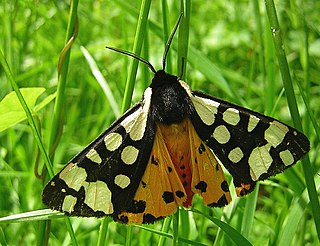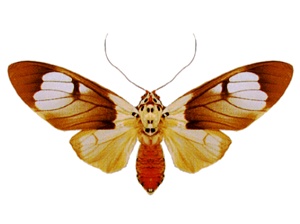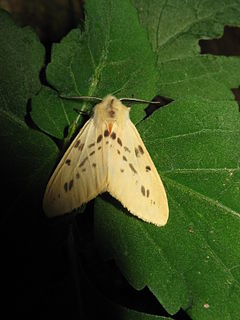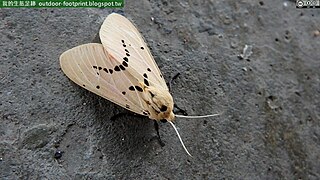
The Arctiinae are a large and diverse subfamily of moths, with around 11,000 species found all over the world, including 6,000 neotropical species. This group includes the groups commonly known as tiger moths, which usually have bright colours, footmen, which are usually much drabber, lichen moths, and wasp moths. Many species have "hairy" caterpillars that are popularly known as woolly bears or woolly worms. The scientific name of this subfamily refers to this hairiness. Some species within the Arctiinae have the word tussock in their common name due to people misidentifying them as members of the Lymantriinae based on the characteristics of the larvae.

Nyctemera is a genus of tiger moths in the family Erebidae first described by Jacob Hübner in 1820. The genus includes the species Nyctemera annulata and Nyctemera amica, which are closely related and are able to interbreed.

The Arctiini are a tribe of tiger moths in the family Erebidae.

The Arctiina are a subtribe of moths in the family Erebidae.

Amerila is a genus of moths in the subfamily Arctiinae. A number of species in this genus have a special defence mechanism when they are in their adult stage. When disturbed, they exude a frothy yellow fluid from glands beside the eyes, while making a sizzling noise to ward off their attacker. Similar behaviour has been observed in fertilised females of the North-American moth Utetheisa ornatrix.

Barsine is a genus of moths in the family Erebidae.
Dolgoma is a genus of moths in the family Erebidae. The genus was described by Moore in 1878.
Eyralpenus is a genus of tiger moths in the family Erebidae. The genus was erected by Arthur Gardiner Butler in 1875. The moths in the genus are found in the Afrotropics.

Palearctia is a genus of tiger moths in the family Erebidae.

Wittia sororcula, the orange footman, is a moth of the family Erebidae. The species was first described by Johann Siegfried Hufnagel in 1766. It is found in Europe, Anatolia and further east across the Palearctic to southern Siberia and the Amur basin to China.
Katha is a genus of tiger moths in the family Erebidae. The genus was erected by Moore in 1878.

Lemyra is a genus of tiger moths in the family Erebidae. The genus contains many species from East and South Asia, Sundaland and Australia. It was described by Francis Walker in 1856.

Lyclene is a genus of lichen moths of the family Erebidae, subfamily Arctiinae. The genus was erected by Frederic Moore in 1860.

Manulea is a genus of moths in the family Erebidae erected by Hans Daniel Johan Wallengren in 1863. The type species is Lithosia gilveola Ochsenheimer, 1810.

Nannoarctia is a genus of moths in the family Erebidae. The genus was erected by Nobutoyo Kôda in 1988.
Oroncus is a genus of tiger moths in the family Erebidae.
Prabhasa is a genus of moths in the family Erebidae.

Spilarctia is a genus of moths in the family Erebidae. The genus was erected by Arthur Gardiner Butler in 1875.
Teracotona is a genus of moths in the family Erebidae from the Afrotropics. The genus was erected by Arthur Gardiner Butler in 1878.

The Nyctemerina are a subtribe of woolly bear moths in the family Erebidae.












